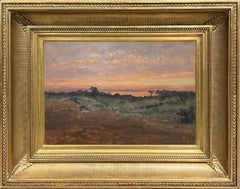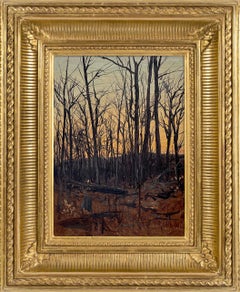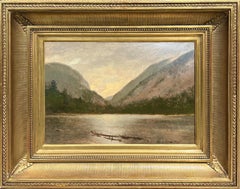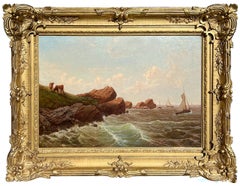Want more images or videos?
Request additional images or videos from the seller
1 of 6
Lemuel Maynard WilesShawangunk Mountains by Lemuel Maynard Wiles (American, 1826-1905)
$13,500List Price
About the Item
- Creator:Lemuel Maynard Wiles (1826 - 1905, American)
- Dimensions:Height: 10 in (25.4 cm)Width: 15 in (38.1 cm)
- Medium:
- Movement & Style:
- Period:
- Condition:
- Gallery Location:New York, NY
- Reference Number:1stDibs: LU2151213775542
About the Seller
5.0
Recognized Seller
These prestigious sellers are industry leaders and represent the highest echelon for item quality and design.
Established in 2004
1stDibs seller since 2022
5 sales on 1stDibs
Authenticity Guarantee
In the unlikely event there’s an issue with an item’s authenticity, contact us within 1 year for a full refund. DetailsMoney-Back Guarantee
If your item is not as described, is damaged in transit, or does not arrive, contact us within 7 days for a full refund. Details24-Hour Cancellation
You have a 24-hour grace period in which to reconsider your purchase, with no questions asked.Vetted Professional Sellers
Our world-class sellers must adhere to strict standards for service and quality, maintaining the integrity of our listings.Price-Match Guarantee
If you find that a seller listed the same item for a lower price elsewhere, we’ll match it.Trusted Global Delivery
Our best-in-class carrier network provides specialized shipping options worldwide, including custom delivery.You May Also Like
Picnic in the Vineyard Spring Contemporary French Impressionist Style Landscape
By Alexandr Rapoport
Located in Soquel, CA
Spring Picnic in the Vineyard, Contemporary Impressionist Landscape
Beautiful oil painting of a variety of fruits with cups in a field of grass by Alexander Rapoport (Russian-Ameri...
Category
21st Century and Contemporary Hudson River School Landscape Paintings
Materials
Canvas, Oil, Illustration Board
$1,160 Sale Price
20% Off
H 23.5 in W 29 in D 0.75 in
Antique American Hudson River School Cows Grazing Signed Framed Oil Painting
By William Hart
Located in Buffalo, NY
Incredible early American Hudson River School landscape painting by William Hart (1823 - 1894). Oil on board. Framed. Signed. Measuring 15 by 17 inches overall and image size, 1...
Category
1870s Hudson River School Landscape Paintings
Materials
Oil, Board
$1,820 Sale Price
20% Off
H 15 in W 17 in D 2 in
Lights of the Aurora
By William Bradford
Located in New York, NY
Signed lower right: W Bradford
Category
Late 19th Century Hudson River School Landscape Paintings
Materials
Oil, Board
Fairhaven Harbor (Old Tack Works Wharf)
By William Bradford
Located in New York, NY
Signed lower right: Bradford
Category
19th Century Hudson River School Landscape Paintings
Materials
Oil, Paper, Board
Antique American Hudson River School Scalp Level Pennsylvania Landscape Painting
Located in Buffalo, NY
Impressive early American Hudson River School landscape oil painting by Jasper Holman Lawman (1825 - 1906). Framed. Oil on board. Signed. Image size, 10H by 16L.
Category
1870s Hudson River School Landscape Paintings
Materials
Oil, Board
$11,800 Sale Price
20% Off
H 16 in W 22 in D 3 in
Antique Early American Southern Hudson River School Boys Swimming Oil Painting
Located in Buffalo, NY
Rare early American sunset Hudson River School swimming hole painting. Framed. Oil on board. Image size, 7.25H by 10L.
Category
1860s Hudson River School Portrait Paintings
Materials
Oil, Board
$3,000 Sale Price
20% Off
H 9 in W 12.5 in D 1 in
Antique American Sunset Seascape Giltwood Framed New England Harbor Oil Painting
Located in Buffalo, NY
Antique American sunset seascape oil painting. Oil on board. Signed. Framed. Measuring: 18 by 24 inches overall, and 12.25 by 18 painting alone.. In excellent original condition. Ha...
Category
1850s Hudson River School Figurative Paintings
Materials
Oil, Board
$2,475
H 18 in W 24 in D 2 in
Antique American Hudson River School Mountain Landscape Framed Signed Painting
By George Herbert McCord
Located in Buffalo, NY
This atmospheric 19th-century oil painting by George H. McCord (1848–1909) depicts a wooded riverbank under a dynamic sky, rendered with the crisp naturalism and luminist subtlety as...
Category
1870s Hudson River School Landscape Paintings
Materials
Oil, Board
$3,475
H 22 in W 17 in D 2 in
The Columbian Exhibition, the 1893 Chicago World’s Fair
Located in Saratoga Springs, NY
Thaddeus Welch (American 1844-1919)
The Columbian Exhibition, the 1893 Chicago World’s Fair
70 x 35”, oil on board signed
Request Price
The C...
Category
Late 19th Century Hudson River School Figurative Paintings
Materials
Oil, Board
Price Upon Request
H 35 in W 70 in D 3 in
19th Century White Mountain Landscape, Unknown American School
Located in New York, NY
Unknown White Mountain Artist
White Mountain Landscape, 19th Century
Oil on board
5 x 9 1/4 in.
Framed: 7 3/4 x 11 3/4 in.
Category
19th Century Hudson River School Figurative Paintings
Materials
Board, Oil
More From This Seller
View AllNew England Sunrise, 1910 by Lockwood DeForest (American, 1850-1932)
Located in New York, NY
"New England Sunrise," 1910 by Hudson River School painter Lockwood DeForest (American, 1850-1932) is oil on artists card-stock and measures 9.75 x 14 inches. The work is signed by DeForest and dated Sept. 17, 1910 at lower left. The work is framed in an elegant, period appropriate frame, and ready to hang.
Lockwood de Forest was born in New York in 1850 to a prominent family. He grew up in Greenwich Village and on Long Island at the family summer estate in Cold Spring Harbor. As was customary for a cultivated family in the Gilded Age, the de Forests made frequent trips abroad. Excursions to the great museums, which were prominent on the de Forests agenda, deepened the young Lockwood's familiarity with European painting and sculpture. Though he had begun drawing and painting somewhat earlier, it was during a visit to Rome in 1868 that nineteen-year-old de Forest first began to study art seriously, taking painting lessons from the Italian landscapist Hermann David Salomon Corrodi (1844–1905). More importantly, on the same trip, Lockwood met one of America’s most celebrated painters, (and his maternal great-
uncle by marriage) Frederic Edwin Church (1826–1900), who quickly became his mentor. DeForest accompanied Church on sketching trips around Italy and continued this practice when they both returned to America in 1869. Early on in his career, de Forest made a habit of recording the date and often the place of his oil sketches, as to create a visual diary of his travels. Lockwood’s profession as a landscape painter can be primarily attributed to Frederic E. Church and his belief in the young artist’s talent.
De Forest often visited Church in the Hudson River community of Catskill where, in addition to sketching trips and afternoons of painting, he assisted with the architectural drawings and planning of Olana. In 1872, de Forest took a studio at the Tenth Street Studio Building in New York. During these formative years de Forest counted among his friend’s artists such as Sanford Robinson Gifford (1823–80), George Henry Yewell (1830–1923), John Frederick Kensett (1816–72), Jervis McEntee (1828–91), and Walter Launt Palmer (1854–1932).
Over the next decade de Forest experienced success as a painter. He exhibited for the first time at the National Academy of Design in 1872, and made two more painting trips abroad, in 1875–76 and 1877–78, traveling to the major continental capitals but also the Middle East and North Africa. His trip to the Middle East and the library at Church’s home, Olana, established his interest in design during his mid-twenties. From about 1878 to 1902, landscape painting was overshadowed by his activities and preoccupation with East Indian architecture and décor, a style that became quite fashionable in late nineteenth century America. From 1879-1883, de Forest founded Associated Artists along with Louis Comfort Tiffany, Candace Wheeler...
Category
Early 20th Century Hudson River School Landscape Paintings
Materials
Oil, Board
Dusk Forest Scene, Catskills by Lockwood DeForest (American, 1850-1932)
Located in New York, NY
"Dusk Forest Scene, Catskills," 1875 by Hudson River School painter Lockwood DeForest (American, 1850-1932) is oil on artists card-stock and measures 9.5 x 7 inches. The work is signed by DeForest, and dated May 13, 1875 at lower right. The work is framed in an elegant, period appropriate frame, and ready to hang.
Lockwood de Forest was born in New York in 1850 to a prominent family. He grew up in Greenwich Village and on Long Island at the family summer estate in Cold Spring Harbor. As was customary for a cultivated family in the Gilded Age, the de Forests made frequent trips abroad. Excursions to the great museums, which were prominent on the de Forests agenda, deepened the young Lockwood's familiarity with European painting and sculpture. Though he had begun drawing and painting somewhat earlier, it was during a visit to Rome in 1868 that nineteen-year-old de Forest first began to study art seriously, taking painting lessons from the Italian landscapist Hermann David Salomon Corrodi (1844–1905). More importantly, on the same trip, Lockwood met one of America’s most celebrated painters, (and his maternal great-
uncle by marriage) Frederic Edwin Church (1826–1900), who quickly became his mentor. DeForest accompanied Church on sketching trips around Italy and continued this practice when they both returned to America in 1869. Early on in his career, de Forest made a habit of recording the date and often the place of his oil sketches, as to create a visual diary of his travels. Lockwood’s profession as a landscape painter can be primarily attributed to Frederic E. Church and his belief in the young artist’s talent.
De Forest often visited Church in the Hudson River community of Catskill where, in addition to sketching trips and afternoons of painting, he assisted with the architectural drawings and planning of Olana. In 1872, de Forest took a studio at the Tenth Street Studio Building in New York. During these formative years de Forest counted among his friend’s artists such as Sanford Robinson Gifford (1823–80), George Henry Yewell (1830–1923), John Frederick Kensett (1816–72), Jervis McEntee (1828–91), and Walter Launt Palmer (1854–1932).
Over the next decade de Forest experienced success as a painter. He exhibited for the first time at the National Academy of Design in 1872, and made two more painting trips abroad, in 1875–76 and 1877–78, traveling to the major continental capitals but also the Middle East and North Africa. His trip to the Middle East and the library at Church’s home, Olana, established his interest in design during his mid-twenties. From about 1878 to 1902, landscape painting was overshadowed by his activities and preoccupation with East Indian architecture and décor, a style that became quite fashionable in late nineteenth century America. From 1879-1883, de Forest founded Associated Artists along with Louis Comfort Tiffany, Candace Wheeler...
Category
19th Century Hudson River School Landscape Paintings
Materials
Oil, Board
Hudson Highlands by Lockwood DeForest (American, 1850-1932)
Located in New York, NY
"Hudson Highlands," by Hudson River School painter Lockwood DeForest (American, 1850-1932) is oil on artists card-stock and measures 9.5 x 14 inches. The work is framed in an elegant, period appropriate frame, and ready to hang.
Lockwood de Forest was born in New York in 1850 to a prominent family. He grew up in Greenwich Village and on Long Island at the family summer estate in Cold Spring Harbor. As was customary for a cultivated family in the Gilded Age, the de Forests made frequent trips abroad. Excursions to the great museums, which were prominent on the de Forests agenda, deepened the young Lockwood's familiarity with European painting and sculpture. Though he had begun drawing and painting somewhat earlier, it was during a visit to Rome in 1868 that nineteen-year-old de Forest first began to study art seriously, taking painting lessons from the Italian landscapist Hermann David Salomon Corrodi (1844–1905). More importantly, on the same trip, Lockwood met one of America’s most celebrated painters, (and his maternal great-
uncle by marriage) Frederic Edwin Church (1826–1900), who quickly became his mentor. DeForest accompanied Church on sketching trips around Italy and continued this practice when they both returned to America in 1869. Early on in his career, de Forest made a habit of recording the date and often the place of his oil sketches, as to create a visual diary of his travels. Lockwood’s profession as a landscape painter can be primarily attributed to Frederic E. Church and his belief in the young artist’s talent.
De Forest often visited Church in the Hudson River community of Catskill where, in addition to sketching trips and afternoons of painting, he assisted with the architectural drawings and planning of Olana. In 1872, de Forest took a studio at the Tenth Street Studio Building in New York. During these formative years de Forest counted among his friend’s artists such as Sanford Robinson Gifford (1823–80), George Henry Yewell (1830–1923), John Frederick Kensett (1816–72), Jervis McEntee (1828–91), and Walter Launt Palmer (1854–1932).
Over the next decade de Forest experienced success as a painter. He exhibited for the first time at the National Academy of Design in 1872, and made two more painting trips abroad, in 1875–76 and 1877–78, traveling to the major continental capitals but also the Middle East and North Africa. His trip to the Middle East and the library at Church’s home, Olana, established his interest in design during his mid-twenties. From about 1878 to 1902, landscape painting was overshadowed by his activities and preoccupation with East Indian architecture and décor, a style that became quite fashionable in late nineteenth century America. From 1879-1883, de Forest founded Associated Artists along with Louis Comfort Tiffany, Candace Wheeler...
Category
19th Century Hudson River School Landscape Paintings
Materials
Oil, Board
Cattle by the Sea, c. 1867 by Ann Sophia Towne Darrah (American, 1819-1881)
Located in New York, NY
"Cattle by the Sea," c. 1867 by historic woman artist Ann Sophia Towne Darrah (American, 1819-1881) was exhibited at the Pennsylvania Academy of the Fine Arts in 1867. Painted in oil...
Category
19th Century Hudson River School Landscape Paintings
Materials
Oil, Canvas
Summer at the Farm by James McDougal Hart (American, 1828-1901)
By James McDougal Hart
Located in New York, NY
"Summer at the Farm," by Hudson River School painter James McDougal Hart (American, 1833-1915) is oil on canvas and measures 14 x 24 inches. It is signed and dated by Hart at the low...
Category
19th Century Hudson River School Landscape Paintings
Materials
Canvas, Oil
A Day in November, 1863 by James MacDougal Hart (American: 1828–1901)
By James McDougal Hart
Located in New York, NY
A prominent 19th century landscapist, Hudson River School painter James McDougal Hart's (1828-1901) A Day in November, 1863 is oil on canvas and measures 10.5 x 18 inches. The painti...
Category
19th Century Hudson River School Landscape Paintings
Materials
Oil, Canvas
Recently Viewed
View AllMore Ways To Browse
Hamilton Oil Painting
John Augustus
Long Island Painting
Mid Century Oil Painting Ray
Night Sky Paintings
Oil Painting Of Ocean
Paintings Of Beach Scenes
Realist Forest Paintings
Romanticism Painting
Sea To Me
Thomas Anshutz
Urban Realism
1977 Oil Painting
American Barn Paintings
Ara Hakobyan
Artist Signed Impressionist
Baltimore Paintings
California Mission



